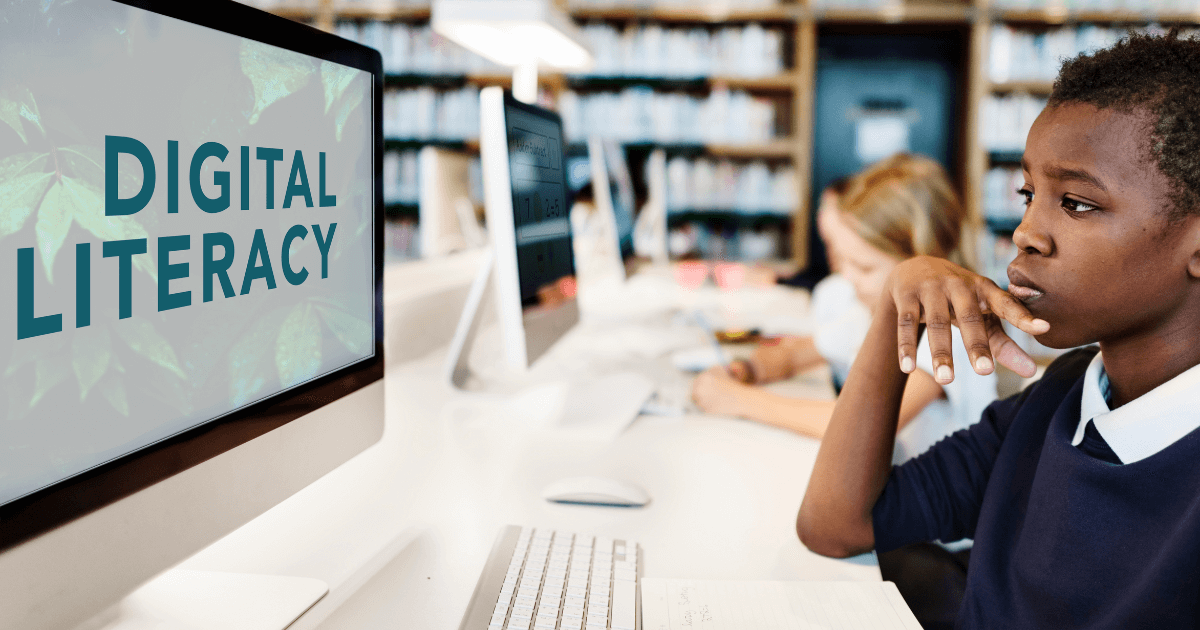There are all sorts of ‘literacies’ that we now associate with 21st century education. They include anything from financial literacy to media literacy and, especially in our modern world, digital literacy skills. Of course, digital literacy might be paramount among them since it's continuing to become more important every day. Today’s kids almost inherit digital literacy skills but there’s a lot more to digital literacy than using a device. As such, creating opportunities for kids to build digital literacy skills from early on in their lives often helps them grow up to develop relevant digital proficiencies along with the ability to use their skills to the fullest.
The Meaning of Digital Literacy
Digital literacy consists of various elements when you really think about it but, by now, many educators have grasped the basic meaning. By itself, the word ‘literacy’ tends to signify possessing all the necessary skills to accomplish something. Thus, literate people can read words as they're written and understand the core meaning of each one. For people who are ‘tech literate,’ they can efficiently utilize technology to make things easier. Similarly, digital literacy remains a huge topic in this day and age—both in education and also beyond. In terms of digital literacy, it essentially involves an ability to use and maximize new technology for good. This includes tools we use to find information, communicate, navigate websites, or build webpages.
Digital literacy in education.
At the intersection of technology and literacy, students tend to develop specific skills that will help them in the future. Whether they find themselves in a STEM profession or another career, today’s children will need digital literacy skills in order to effectively discover, evaluate, and communicate relevant information. It also means that they'll need to develop these cognitive and technical skills starting at a younger age. In a broad sense, possessing strong digital literacy skills means that someone can quickly find, consume, create, and share digital content—something that might seem simple at this point, but is still overlooked at times. Plus, there are also plenty of nuances and specific areas of digital technology for students to explore.
Using digital tools for good.
Knowing how to interact with and use digital materials is one element of digital literacy and knowing how to leverage digital devices for your own benefit is another. Some specific digital literacies include more refined skills that serve people well these days—most notable of which is coding. Coding (or programming) plays a critical role in this digital world since computer science drives so much of today’s economy. In fact, some people even compare knowing how to read and write computer code to having the ability to read or write in general. As such, being digitally literate involves many facets so, rather than focusing on developing one literacy, becoming fluent in many is likely what will serve students best down the road.
Developing Digital Literacy in Today’s Students
As we mentioned, today’s students are pretty much born into technology, which brings its share of benefits and drawbacks. Of course, they are also tech-savvy and understand this significance of technology in their everyday lives. It could also, however, create some complacency if they think they already know everything about it. Most times, there still are plenty of digital literacy skills students can learn beyond navigating their devices. Possessing strong digital literacy skills can be the difference between finding a long-term job in a thriving field or doing something that won't provide as bright of a future. It may seem odd to think about it that way but, sometimes, this can be accurate.
Digital literacy as a new (but important) competency.
The fact is that high test scores and educational achievements don’t always translate to more lucrative job offers. It, of course, depends on what students want to do but, if it’s a STEM field they’re pursuing, there’s a good chance they’re going to need strong digital skills, too. This may be a bit of an oversimplification but will having good test taking skills lead to someone finding a creative solution to a highly complex problem? It’s no guarantee but, at the same time, comfortability with digital tools can help students realize that these resources are helpful. Today, we live in this global economy of communication, collaboration, and problem solving—and each involves digital skills somehow.
Developing digital skills for the right reasons.
Since we live in a digital age, students do need digital skills. This goes beyond simply feeling comfortable with technology and more with using it to solve problems and connect with peers. For this purpose, some digital tools are more appropriate than others. While kids might excel at navigating social media apps with their eyes closed, this isn’t the best use of skills. Using this familiarity with technology, however, kids could start to practice their coding and computational thinking skills from a young age, which goes hand in hand with developing stronger digital literacy. It's also a great start to ensure children aren’t at any disadvantage and it’s fairly easy to implement and maintain.

Assessing Digital Literacy Skills
Leading some lessons that incorporate mixtures of educational technology tools and digital literacy skills is great. In fact, that sounds pretty much perfect—especially with kids in the early grades. Simply giving them more chances to develop their digital literacy skills is not always enough, however. Like with any classroom lesson, instructors must ensure that the most important things do, in fact, stick with students. Assessment, especially formative assessment, is a pretty big part of 21st century education and teachers can certainly use it to gauge digital proficiencies of each kid. First, these teachers must know what to look for—meaning they need a fair amount of digital literacy skills themselves. After all, how could they ever evaluate a child’s progress if they're not sure what progress is?
Using various digital tools in assignments.
If students have stronger digital literacy skills, they can usually use ICT tools to find, evaluate, create, and share information. Doing this requires a mixture of technical and cognitive skills, which are also key in the real world. Although the same digital literacy tools and skills aren't necessarily the most beneficial among students in college as opposed to those beginning their careers, many of them are still important in some way. When teachers assess the digital capabilities their students have, they can better understand which tech tools they should use in their classroom—whether that’s computer-based programs, STEM tools, or other tactile technologies. If kids are capable, using various technologies often helps them communicate, complete projects, and collaborate.
Carrying digital literacy skills into the real world.
Ensuring that students are digitally literate will even serve them well as they prepare for college or a career. Digital literacy covers things as basic as connecting to a network and storing data in various places. It also involves learning and participating effectively when they’re not in the same physical location. If you were to think about it, so many of the projects in today’s economy involve remote workers. So, if students have the chance to try this and perfect it, they're that much more valuable to future employers. Teachers should also pay attention to whether or not students know how to select the right tech tools to use in certain situations and the features of their own assessment tools. Whether digital literacy assessments happen online or not, they’re important and can make a difference in student development.
Using Digital Literacy to Prepare Kids for the Future
New jobs are constantly emerging and the only thing more certain than the fact that today’s students might be doing something brand new is that they will probably rely on technology. In fact, a lot of these new roles in today’s economy emerge because of technology. So, it seems logical to think that digital literacy is going to play a sizable role in their futures. Whether it’s basic digital skills, like navigating the Internet, or some of the more advanced abilities, like coding, today’s students will likely need to be more skilled in these digital competencies than the people they're competing with for jobs. With more access to technology than ever, however, students have opportunities to get ready for future challenges.
Turning screen time into a positive.
Today’s students spend a lot of time in front of screens and, let's just say, it's not all well spent. If even half of it was reallocated to digital literacy, that could prompt various benefits down the road. In reality, so much of this screen time is dedicated to social media and sharing countless images and thoughts among friends. Since this is true, it is vital kids learn the importance of digital citizenship alongside digital competencies. Digital citizenship is important when kids are young and equally important in college and when entering the workforce. Since kids are largely literate when it comes to social media, teachers may want to spend some time discussing these sites, how to act respectfully, and how easy it is to find harmful posts.
Digital citizenship and digital literacy.
With both digital citizenship and digital literacy, kids often learn best from peers and pick up new resources fairly quickly. They could then share this new knowledge with others and serve as mentors while leading by example. Part of digital literacy also entails students knowing how to use technology as well as how to use it respectfully. So, this is when the digital citizenship side of things comes into play and it's a perfect segue for reminding children that they must be safe, smart, and kind when they're using technology. As incoming K-12 students start using technology more regularly, it's good for teachers to keep these thoughts in mind and remind children that all of these points are important.

Knowing the Right Time to Teach Digital Literacy Skills
If you’re like us, you might want to begin teaching students about digital literacy before they even possess regular literacy. While they may start to develop some digital competencies very early on (2-3 years old), at this point, they essentially just rely on trial and error when using digital devices. That’s not to say that those experiences aren’t as valuable, however. Kids who navigate tablets or smartphones are still learning to use them, which is, in fact, some basic digital literacy. In a more traditional sense, children should start learning digital literacy foundations by kindergarten or first grade. By then, they probably use technology a bit more and even rely on it to complete tasks, communicate, or find information for projects. Without overwhelming them, this could be a good time to introduce the concept of digital literacy.
Setting the stage for the future.
Introducing digital literacy early on helps ensure that, as they grow, children develop enough of the digital skills and competencies they need for high school. As time passes, however, just what exactly those skills and competencies are changes. For example, high school students today might benefit from knowing how to use 3D printers for various reasons. And, even elementary students can use these tools since there are printers for kids of all ages. Whatever digital literacy skills they have, children can use these tech tools and become more proficient with writing, reading, and even with math knowledge. Plus, once they start doing more research and longer essays, digital competencies will help tremendously.
Different types of digital literacy.
As early on as kindergarten, kids can access essential digital experiences, like navigating a computer using the mouse and keyboard. Then, teachers can introduce the Internet and, of course, show them how to stay safe online and practice digital citizenship. As they reach upper elementary school, children could try using digital applications over the Web or their device without Internet. When using tech applications for learning, children often develop digital literacy skills like visual mapping, presentation abilities, multimedia familiarity, navigating Internet databases, word processing, and spreadsheet fluency, which are all relevant in the real world. Finally, as they get older, they could take these skills and use them to try coding and computational thinking—bringing their digital literacy development to a higher level.
For the latest EdTech, STEM, and 21st century education news, follow us on Twitter and Instagram. Like us on Facebook, too, or sign up for our newsletter for our latest product announcements and offerings. If you have an idea for an Eduporium Weekly theme, send us a message on social media or comment below.




2 Comments